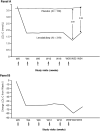Long-term efficacy and safety of lerodalcibep in heterozygous familial hypercholesterolaemia: the LIBerate-HeFH trial
- PMID: 37639462
- PMCID: PMC10590131
- DOI: 10.1093/eurheartj/ehad596
Long-term efficacy and safety of lerodalcibep in heterozygous familial hypercholesterolaemia: the LIBerate-HeFH trial
Abstract
Background and aims: Lerodalcibep, a novel small recombinant fusion protein of a proprotein convertase subtilisin/kexin type 9 gene-binding domain (adnectin) and human serum albumin, demonstrated highly effective low-density lipoprotein cholesterol (LDL-C) reduction with monthly 300 mg in 1.2 mL subcutaneous dosing in Phase 2. In this global Phase 3 trial, the safety and efficacy of lerodalcibep were evaluated in heterozygous familial hypercholesterolaemia patients requiring additional LDL-C lowering.
Methods: Patients were randomized 2:1 to monthly subcutaneous injections of either lerodalcibep 300 mg or placebo for 24 weeks. The primary efficacy endpoints were the per cent change from baseline in LDL-C at Week 24 and the mean of Weeks 22 and 24.
Results: In 478 randomized subjects [mean age (range); 53 (18-80) years, 51.7% female, mean (SD) baseline LDL-C 3.88 (1.66) mmol/L], lerodalcibep reduced LDL-C, compared with placebo by an absolute amount of 2.08 (0.11) mmol/L [LS mean (SE); 95% confidence interval -2.30 to -1.87] with a percentage difference of -58.61 (3.25)% at Week 24 and by 2.28 (0.10) mmol/L (95% confidence interval -2.47 to -2.09) with a percentage difference of -65.0 (2.87)% at the mean of Weeks 22 and 24 (P < .0001 for all). With lerodalcibep, 68% of subjects achieved both a reduction in LDL-C ≥ 50% and the recommended European Society of Cardiology LDL-C targets during the study. Except for mild injection site reactions, treatment-emergent adverse events were similar between lerodalcibep and placebo.
Conclusions: Lerodalcibep, a novel anti-proprotein convertase subtilisin/kexin type 9 gene small binding protein dosed monthly as an alternative to monoclonal antibodies, significantly reduced LDL-C in subjects with heterozygous familial hypercholesterolaemia with a safety profile similar to placebo.
Keywords: Familial hypercholesterolaemia; Lerodalcibep; Low-density lipoprotein cholesterol.
© The Author(s) 2023. Published by Oxford University Press on behalf of the European Society of Cardiology.
Figures





